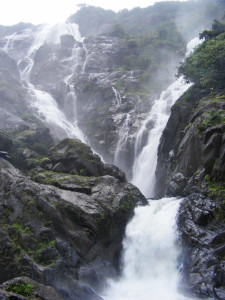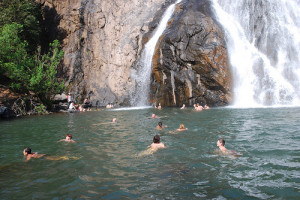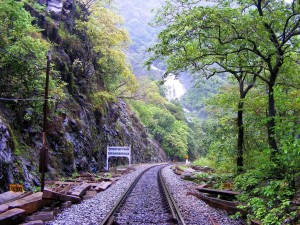The Dudh Sagar waterfall is situated in the Indian state of Goa in Sanguem taluka. It is located 60 kms from the capital city of Panaji and is well connected with Panjim and MargaoDudhsagar is even accessible through buses and taxis which can be taken from Panaji city.
through a rail and road network.
Perched on the lofty peaks of the Western Ghats, the Dudh Sagar waterfalls offer unrivalled beauty, and amazing scenery full of exquisite charms when in full flux after the monsoon showers. Like an idyllic Eden cradled luxuriously in the mountains, the Dudh Sagar waterfalls, which from a distance appear like milky streams, gradually climax into a gushing cascade as they come into full view of the onlookers.
through a rail and road network.
Perched on the lofty peaks of the Western Ghats, the Dudh Sagar waterfalls offer unrivalled beauty, and amazing scenery full of exquisite charms when in full flux after the monsoon showers. Like an idyllic Eden cradled luxuriously in the mountains, the Dudh Sagar waterfalls, which from a distance appear like milky streams, gradually climax into a gushing cascade as they come into full view of the onlookers.
Dudhsagar literally means ocean of milk. This is one of Goa’s most attractive and ideal picnic spots mainly offering charismatic natural beauty and amazing scenery when in full flow after the monsoons. The waterfall initially appears like streams of milk flowing down the mountain which later culminate into gushing cascades after they come in full view of the awestruck visitors. It is perched on the lofty heights of the Western Ghats and falls from a height of 603 meters. The celestial intervention in the origin of these waterfalls adds a mystic significance to Dudhsagar, almost like a dream come true. Even words are too less to describe this stupendous charisma of mythical fascination which is almost similar to a second Eden cradled luxuriously in the mountains.
If you were thinking that Goa is all about white sand and plenty of
sea, think again! Very few tourisdestinations can offer the disparate
experiences that Goa can.


When
you have had your fill of the sea, it’s time to look ahead to the hills
of the Western Ghats. The Dudhsagar Waterfalls is luxuriously enveloped
in greenery and a breathtaking avalanche of milky white water. The word
‘dudhsagar’ literally means ‘ocean of milk’. The waterfalls are so
named because of the white foamy water that comes down from a
staggering height of 2000 feet above the sea level.
Dudhsagar Waterfalls are listed as one of the highest waterfalls in the world. They are the fifth highest waterfalls in India. The waterfall appears as if the streams of milk are flowing down from the mountains.
Dudhsagar Waterfalls are listed as one of the highest waterfalls in the world. They are the fifth highest waterfalls in India. The waterfall appears as if the streams of milk are flowing down from the mountains.
There is a myth associated with Dudh sager waterfalls. Years ago there
lived a powerful and rich king on the top of a mountain in the Western
Ghats along the Goan frontier. He lived in a lavish palace made of pure
ivory and embedded by precious stones. Near this palace, there were
luxuriant gardens abounding in a vast variety of flowers.
At one end of the forest, which fringed the king's palace, there was a picturesque lake. In the panoramic setting of this lake, the king's daughter, accompanied by her ladies-in-waiting, went to bathe and to sip sugared milk which one of her maids served to her in a pure gold jug.
One day, while she was sipping at the milk, a prince, who was passing by, stopped on hearing the sound of people nearby. Immediately, the princess poured the milk in the pond to shield her body from the glances of the stranger. It is believed that the sugared milk that was poured by the virtuous and modest princess still comes flowing down in torrents along that side of the mountain.
Dudh Sagar waterfalls with their strange, mystical fascination are a dream come true. The uneclipsed vision, furnished by this native waterfall as it plunges over crag-covered precipes and stupendous steeps, belies description.
At one end of the forest, which fringed the king's palace, there was a picturesque lake. In the panoramic setting of this lake, the king's daughter, accompanied by her ladies-in-waiting, went to bathe and to sip sugared milk which one of her maids served to her in a pure gold jug.
One day, while she was sipping at the milk, a prince, who was passing by, stopped on hearing the sound of people nearby. Immediately, the princess poured the milk in the pond to shield her body from the glances of the stranger. It is believed that the sugared milk that was poured by the virtuous and modest princess still comes flowing down in torrents along that side of the mountain.
Dudh Sagar waterfalls with their strange, mystical fascination are a dream come true. The uneclipsed vision, furnished by this native waterfall as it plunges over crag-covered precipes and stupendous steeps, belies description.
The name of this waterfall evolves from the Konkani name for the falls,
Dudhsagar meaning 'sea of milk'. This is because froth is formed due to
the speedy surge of water from the majestic heights.
Inspite of being a perilous spot due to its slippery rocks, it is a
popular site for trekking and hiking. The fall looks stunning post
monsoon as it ripples with bubbling foam-like water.
The fall overlooks a steep, crescent-shaped edge of a valley covered
with beautiful tropical forest.
Monkeys, birds, bees, butterflies have carved their own niche amidst
the flora of the region and the plunge pool abounds in aquatic life.
The Dudhsagar Falls is one of the most interesting falls of India and
the largest and highest fall of Goa. Nearby is the Tamdi Surla Temple
built by the Kadambas.
The road to this mighty fall is inaccessible during the
monsoon season .The Goa Tourism Development Corporation (GTDC) runs
tours to Dudhsagar on Saturday and Sunday from Panaji and Calangute.
You could also take a train to Dudhsagar from Madgaon (Margao) and get
there in an hour and half. However during summer, when the level of the
water is low, you can hire a Jeep and access the foot of the falls from
either Molem or Collem.
Dudhsagar waterfalls are located in the district of Sanguem in Goa.
It lies at the distance of 60 km from Margao near the Goa Karnataka
border. The falls take a steep plunge 2000 feet down in the wooden
mountains of the western ghats. It originates high up on the river
Mandovi’s watershed.
Flora and Fauna :

Dudhsagar
waterfalls are the tourists hotspot because of its sylvan surroundings.
The falls are located amidst the blissful tropical jungle. Lots of
naughty monkeys can be spotted on the forests tress climbing, jumping
and playing among themselves. Dudhsagar waterfalls is the popular
birding site among the tourists. You can carry the binoculars along
with yourself to indulge in bird watching. You may notice lots of
species of butterflies and bees at this place. Apart from the birds and
animals the region holds the rich aquatic life.
Other Attractions
While you are at the Dudhsagar Waterfalls, a visit to the Bhagwan Mahavir Wildlife Sanctuary can not be missed. It is the largest wildlife Sanctuary in India. The main attraction of the park are Royal Bengal Tigers, Barking deer, Blank Panther, bonnet macaque, common langur, civet, flying squirrel, gaur, leopards, mouse deer, pangolin, porcupine, sambar, spotted deer, wild boar and wild dog.
While you are at the Dudhsagar Waterfalls, a visit to the Bhagwan Mahavir Wildlife Sanctuary can not be missed. It is the largest wildlife Sanctuary in India. The main attraction of the park are Royal Bengal Tigers, Barking deer, Blank Panther, bonnet macaque, common langur, civet, flying squirrel, gaur, leopards, mouse deer, pangolin, porcupine, sambar, spotted deer, wild boar and wild dog.
Swimming at Dudhsagar :

Tourists
can indulge in swimming in the pools created by the fall. Swimming at
these pools is extremely delightful and safe too. The water is really
climb. You can even try to climb the head of the falls through the
bushes falling into the pools. During the monsoons the falls become
much more lively and active. The natural beauty all around the
Dudhsagar Waterfalls has also made it a popular picnic destination
among the tourists.
Trekking at Dudhsagar :

Dudhsagar
Waterfall is famed as the trekking destination. It is the trekkers
paradise. Tourists are recommended to wear the comfortable clothes
while trekking. It is good to carry the rainy coat along with yourself.
The trek passes through the lush forests, giving you the opportunity to
have encounter with the wilds. You can capture the beautiful sceneries
of the environment in your camera. You will be fully entertained with
the calls of the jungle. You can even feed the monkeys with the bananas
on the way. Beware of the poisonous snakes on the treks which could be
dangerous. Otherwise trekking here is quite a fun.
Accommodations:
There are not much options near Dudhsagar falls. There is a Forest rest-house, owned by KTDC, near the falls. Else visitors can stay at Margoa and plan a one day trip to Dudhsagar Falls.
There are not much options near Dudhsagar falls. There is a Forest rest-house, owned by KTDC, near the falls. Else visitors can stay at Margoa and plan a one day trip to Dudhsagar Falls.
Reaching there:
You can very easily reach Dudhsagar waterfalls by hiring a taxi or a bus from Panaji or Margao. The ideal time to visit the Dudhsagar waterfall lies after the monsoons, from the month of October till December.
You can very easily reach Dudhsagar waterfalls by hiring a taxi or a bus from Panaji or Margao. The ideal time to visit the Dudhsagar waterfall lies after the monsoons, from the month of October till December.
Dudhsagar Waterfalls- springing from from a lofty height of 600m is
located on the Goa-Karnataka border. It lies at a distance of 60 km
from Panaji and 10 km from Colem Railway Station.
























